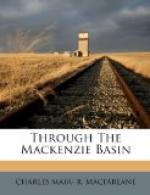[It may be mentioned here that this half-breed’s “inner” name, so to speak, meant “The Ghost-Keeper,” for the name he gave, following an Indian usage, was not the real one. Kanawatchaguayo was the one given by the interpreter, but accompanied by the translation of the inner name, to wit, “The Ghost-Keeper.” This curious custom is more fully referred to in a forthcoming work on Indian folk-lore, traditions, legends, usages, methods and manner of life, etc., by Mrs. F. H. Paget, of Ottawa. This lady is an expert Cree scholar, and her work, which I have had the pleasure of hearing her read, is the result of diligent research and of ample knowledge of Indian life and character.]
But others were strikingly poetical, particularly the female names. Payucko geesigo, “One in the Skies”; Pesawakoona kapesisk, “The silent snow in falling forming signs or symbols”; Matyatse wunoguayo, or rather, for this is a doubtful name, Powastia ka nunaghquanetungh, “Listener to the unseen rapids”; Kese koo apeoo, “She sits in heaven,” were all the names of applicants for scrips, and many others could be added of like tenor. In a word, the Christian or baptismal names have not displaced the native ones, as they did in Wales and elsewhere, and amongst some of our far Eastern Indians. But there were terrifying and repulsive names as well, such as Sese kenapik kaow apeoo, “She sits like a rattle-snake”; and one individual rejoiced in the appalling surname of “Grand Bastard.” These instances serve to illustrate the tendency of half-breed nomenclature at the lake towards the mother’s side. Here, too, there was no reserve in giving the family name; it was given at once when asked for, and there was no shyness otherwise in demeanour. There was a readiness, for example, to be photographed which was quite distinctive. In this connection it may interest the reader to recall some of the names of girls given by the same race thousands of miles




